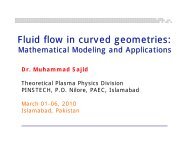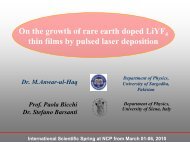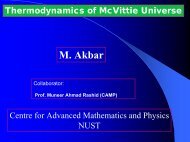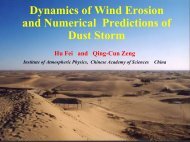Non-linear electrostatic waves in pair-ion plasmas - National Centre ...
Non-linear electrostatic waves in pair-ion plasmas - National Centre ...
Non-linear electrostatic waves in pair-ion plasmas - National Centre ...
You also want an ePaper? Increase the reach of your titles
YUMPU automatically turns print PDFs into web optimized ePapers that Google loves.
<strong>Non</strong><strong>l<strong>in</strong>ear</strong> <strong>electrostatic</strong> structures <strong>in</strong>unmagnetized <strong>pair</strong>-<strong>ion</strong> (fullerene) <strong>plasmas</strong>S. MahmoodTheoretical Plasma Physics Divis<strong>ion</strong>, PINSTECH IslamabadCollaborators:H. SaleemNat<strong>ion</strong>al Center for Physics, QAU Campus IslamabadandW. Masood, H. Ur-Rehman and N. ImtiazTheoretical Plasma Physics Divis<strong>ion</strong>, PINSTECH Islamabad2 nd Internat<strong>ion</strong>al Scientific Spr<strong>in</strong>g Conference, March 01-06 2010, NCP Islamabad1
Outl<strong>in</strong>e of presentat<strong>ion</strong>1. Introduct<strong>ion</strong> of soliton2. Brief <strong>in</strong>troduct<strong>ion</strong> of <strong>pair</strong>-<strong>ion</strong> (fullerene)<strong>plasmas</strong>3. Model for <strong>electrostatic</strong> <strong>waves</strong> <strong>in</strong> <strong>pair</strong>-<strong>ion</strong><strong>plasmas</strong>4. KdV solitons5. Double layer structures <strong>in</strong> <strong>pair</strong>-<strong>ion</strong> <strong>plasmas</strong>6. Kadomstev-Petviashvili-Burgers (KPB)equat<strong>ion</strong> is obta<strong>in</strong>ed for solitons andshocks <strong>in</strong> PI <strong>plasmas</strong>7. Conclus<strong>ion</strong>2
1. Soliton‣ Soliton is a non<strong>l<strong>in</strong>ear</strong> structure (bell shaped) which conserves itsshape and <strong>in</strong>teracts with surround<strong>in</strong>gs or other solitons as an<strong>in</strong>dependent particle.‣ Solitons are robust aga<strong>in</strong>st perturbat<strong>ion</strong>s.‣ Soliton was first noticed <strong>in</strong> the month of August 1834 by the Scottisheng<strong>in</strong>eer John Scott Russell (1808-1882), while conduct<strong>in</strong>gexperiments to determ<strong>in</strong>e the most efficient design for canal boatsalong the Un<strong>ion</strong> canal l<strong>in</strong>k<strong>in</strong>g Ed<strong>in</strong>burg with Glasgow.‣ In 1885, Korteweg and de Vries derived a model equat<strong>ion</strong> (knownas KdV equat<strong>ion</strong>) for the dynamics of non<strong>l<strong>in</strong>ear</strong> wave as follows,3∂u∂u∂ u+ au + b3∂t∂x∂x= 0Here a and b are non zero constants, which depends on fluid properties.The KdV equat<strong>ion</strong> posses a soliton (or solitray wave) solut<strong>ion</strong>.3
Soliton (contd.)Fig.1.2: Soliton solut<strong>ion</strong>s of stat<strong>ion</strong>ary KdV equat<strong>ion</strong>. The speed of solitondepends on its amplitude.4
Soliton <strong>in</strong> Plasmas (contd.)L<strong>in</strong>ear <strong>waves</strong> <strong>in</strong> v r<strong>plasmas</strong> are studied by assum<strong>in</strong>g a harmonic wavei( k .−ωt)solut<strong>ion</strong> ~ e<strong>in</strong> the small amplitude limit.When the wave amplitude is sufficiently large the non<strong>l<strong>in</strong>ear</strong>ities cannotbe ignored.<strong>Non</strong><strong>l<strong>in</strong>ear</strong>ities <strong>in</strong> <strong>plasmas</strong> enter through‣ Harmonic generat<strong>ion</strong> (<strong>in</strong>volv<strong>in</strong>g fluid convect<strong>ion</strong>),‣ <strong>Non</strong><strong>l<strong>in</strong>ear</strong> Lorentz force,‣ Ponderomotive force, trapp<strong>in</strong>g of the particles <strong>in</strong> the wavepotential etc.Importance <strong>in</strong> PlasmasThe study of soliton is important to understand the particle orenergy transport mechanisms <strong>in</strong> <strong>plasmas</strong>.5
<strong>Non</strong><strong>l<strong>in</strong>ear</strong> Plasma DynamicsWhen wave amplitude grows to such high values that <strong>l<strong>in</strong>ear</strong> perturbat<strong>ion</strong>theory cannot be applied to describe the <strong>in</strong>teract<strong>ion</strong>s <strong>in</strong> <strong>plasmas</strong>. Then<strong>in</strong>stead of apply<strong>in</strong>g Fourier analysis, we transform the orig<strong>in</strong>al set ofnon<strong>l<strong>in</strong>ear</strong> equat<strong>ion</strong>s, that describe the wave dynamics, <strong>in</strong>to lowest ordernon<strong>l<strong>in</strong>ear</strong> equat<strong>ion</strong>s (such as KdV equat<strong>ion</strong>, Burgers equat<strong>ion</strong> and NLSequat<strong>ion</strong>) whose properties are well known.For arbitrary amplitude <strong>waves</strong>, one has to solve the non<strong>l<strong>in</strong>ear</strong> differentialequat<strong>ion</strong>s with full non<strong>l<strong>in</strong>ear</strong> glory and difficulties. This method haslimitat<strong>ion</strong>s and cannot be used <strong>in</strong> general and applicable to only somespecific problems.Reductive perturbat<strong>ion</strong> method is used when one cannot deal theequat<strong>ion</strong>s with full non<strong>l<strong>in</strong>ear</strong>ity and weak non<strong>l<strong>in</strong>ear</strong>ity are assumed <strong>in</strong> thesystem. The stretched variables <strong>in</strong> space and time are def<strong>in</strong>ed and slowtime variat<strong>ion</strong>s are <strong>in</strong>duced by the non<strong>l<strong>in</strong>ear</strong>ity of the system. For example,the KdV equat<strong>ion</strong> is obta<strong>in</strong>ed for low amplitude non<strong>l<strong>in</strong>ear</strong> wave with6appropriate scal<strong>in</strong>g of space and time variables.
2. Brief Introduct<strong>ion</strong> of <strong>pair</strong>-<strong>ion</strong> Plasmas‣In usual electron-<strong>ion</strong> <strong>plasmas</strong>, asymmetry <strong>in</strong> collective phenomenonoccur due to large difference of mass between electrons and <strong>ion</strong>s.‣However, <strong>pair</strong> <strong>plasmas</strong> (e-p) consists of positively and negativelycharged particles of same mass to keep the space, time symmetrybecause the mobility of equal mass particles is same <strong>in</strong> theelectromagnetic field.‣Pair plasma consists of positrons and electrons have been produced<strong>in</strong> laboratory experiments. But the identificat<strong>ion</strong> of collective modes isvery difficult because the annihilat<strong>ion</strong> time is short compared with theplasma period.‣Therefore, attent<strong>ion</strong> is concentrated on the stable generat<strong>ion</strong> of a<strong>pair</strong>-<strong>ion</strong> plasma <strong>in</strong> laboratory consist<strong>in</strong>g of positive and negative <strong>ion</strong>swith an equal mass for collective modes identificat<strong>ion</strong>.‣It has been found that fullerene (C 60) can be adopted as an <strong>ion</strong>source for <strong>pair</strong>-<strong>ion</strong> plasma product<strong>ion</strong>, based on the fact that<strong>in</strong>teract<strong>ion</strong> of electrons with fullerenes lead to the product<strong>ion</strong> of bothnegative and positive <strong>ion</strong>s.7
A fullerene is any molecule composed entirely of carbon, <strong>in</strong> the form of ahollow sphere, ellipsoid, or tube. Spherical fullerenes are also calledbuckyballs, and cyl<strong>in</strong>drical ones are called carbon nano-tubes or buckytubes.The discovery of fullerenes greatly expanded the number of known carbonallotropes, which until recently were limited to graphite, diamond, and amorphous8carbon such as soot and charcoal.
Product<strong>ion</strong> of <strong>pair</strong>-<strong>ion</strong> (fullerene) PlasmasChamberLength=260 cm,diameter=15.7 cm,B=0.3 T (solenoidcoils), gas pressure=2x10 -4 PaE e=0 - 150 eV(electron beamenergy)The product<strong>ion</strong> process of <strong>pair</strong>-<strong>ion</strong> plasma is divided <strong>in</strong>to three reg<strong>ion</strong>s:Reg<strong>ion</strong> I: Consists of electron beam reg<strong>ion</strong> and fullerene <strong>ion</strong> product<strong>ion</strong> reg<strong>ion</strong>.+Positive <strong>ion</strong>s C 60 are produced by electron impact <strong>ion</strong>izat<strong>ion</strong> and low energyelectrons are produced <strong>in</strong> connect<strong>ion</strong> with this process.−Negative <strong>ion</strong>s C 60 are produced by attachment of these low energy electronsproduced dur<strong>in</strong>g the charg<strong>in</strong>g process of positive <strong>ion</strong>s.C 260− + −+ e → C60+ e,+−242( C60)= 25×10 cm− −C60 + e → C ,−−24260σ ( C60)= 100 × 10 cmσat 100 eVat 5eV9
Product<strong>ion</strong> of <strong>pair</strong>-<strong>ion</strong> (fullerene) Plasmas (contd.)Reg<strong>ion</strong> II: Electrons and <strong>ion</strong>s are rapidly separated by a magnetic filter<strong>in</strong>g+−effect and only and are expected to exist <strong>in</strong> midmost of the cyl<strong>in</strong>der.C 60C 60Charge particle gyroradii ~(mass) 1/2 /charge+C 60−C 60(for same thermal velocity <strong>in</strong> theperpendicular direct<strong>ion</strong> of B)Reg<strong>ion</strong> III: Electron free <strong>pair</strong>-<strong>ion</strong> ( , ) plasma generated is atta<strong>in</strong>ed hereand plasma parameters are measured by Langmuir probes.The typical values of <strong>pair</strong>-<strong>ion</strong> plasma density ~ 2x10 8 cm -3 at E e=100eVThe temperature of the positively and negatively charged fullerene <strong>ion</strong>s lies <strong>in</strong>the range 0.3-0.5 eV.[W. Oohara, Y. Kuwabara and R. Hatakeyama, PRE 75, 056403 (2007)]The temperature of positive <strong>ion</strong>s is found to be different from negativefullerene <strong>ion</strong>s because the charg<strong>in</strong>g processes are quite different for boththe plasma species.10
Electrostatic Waves <strong>in</strong> <strong>pair</strong>-<strong>ion</strong> PlasmasW. Ohara, D. Date and H. Hatakeyama [PRL 95,175003 (2005)], firstly reportedthe <strong>electrostatic</strong> <strong>waves</strong> <strong>in</strong> <strong>pair</strong>ed fullerene-<strong>ion</strong> <strong>plasmas</strong>.Three types of <strong>electrostatic</strong> <strong>waves</strong> can propagate parallel to the magnetic field<strong>in</strong> <strong>pair</strong>-<strong>ion</strong> <strong>plasmas</strong> i.e.,2 2 2 2 γT1. Ion acoustic wave (IAW) ω = C sk , C s= (acoustic speed)m2. Intermediate frequency wave (IFW)2 2 2 23. Ion plasma wave (IPW)ω = C + ωThe IFW has the features that group velocity is negative but the phasevelocity is positive i.e., the mode resembles as a backward wave.11sk2 p
3. <strong>Non</strong><strong>l<strong>in</strong>ear</strong> Electrostatic Waves <strong>in</strong> <strong>pair</strong>-<strong>ion</strong> PlasmasModel and non<strong>l<strong>in</strong>ear</strong> set of equat<strong>ion</strong>sConsider homogeneous, unmagnetized fullerene (C 60) plasma consists of positivelyand negatively charged <strong>ion</strong>s.The positive and negative <strong>ion</strong>s are considered to be isothermally heated but havedifferent temperatures.Us<strong>in</strong>g two fluid theory, the Cont<strong>in</strong>uity equat<strong>ion</strong>s of positive and negative<strong>ion</strong>s are given as∂n∂t+∂+ ( nv+ + ) =∂x0(1)∂n∂t−∂+ ( nv− −)=∂x0(2)12
<strong>Non</strong><strong>l<strong>in</strong>ear</strong> Electrostatic Waves <strong>in</strong> Pair-<strong>ion</strong> Plasmas (contd.)Momentum equat<strong>ion</strong>s for positively and negatively charged <strong>ion</strong>s are describedas,(where φ is <strong>electrostatic</strong> potential) i.e.,2∂ φPoisson equat<strong>ion</strong> gives, = 4π e n− −2 +∂xEquilibrium is def<strong>in</strong>ed as,∂ v+ ∂v+e ∂φT+1 ∂n++ v+= − −∂t∂xm ∂xm n ∂x∂v∂t∂v+∂φ−∂x− − e− 1+ v−=∂xm−m−n−( n )( )n = n = n say0+ 0−0T++∂n−∂x∂φE = −∂x(3)(4)(5)(6)Dispers<strong>ion</strong> relat<strong>ion</strong>⎡⎢⎢⎣1 1⎤1+ ⎥ − =− + ⎦2 2 2 2 2 2 2( ω −VTk ) ( ω −VTk ) ⎥ ωp0(7)whereVTα⎛Tα⎞= ⎜ ⎟⎝m⎠12andωp12 2⎛4πne ⎞0= ⎜ ⎟⎝ m ⎠m +=m -(=m say)13
<strong>Non</strong><strong>l<strong>in</strong>ear</strong> Electrostatic Waves <strong>in</strong> <strong>pair</strong>-<strong>ion</strong> Plasmas (contd.)L<strong>in</strong>ear analysis of the modes <strong>in</strong> <strong>pair</strong>-<strong>ion</strong> <strong>plasmas</strong>Case (i)If T +=T -(=T say), then Eq.(7) givesω= 2ω+ V k2 2 2 2p Twhich is the usual Langmuir <strong>waves</strong> <strong>in</strong> <strong>pair</strong>-<strong>ion</strong> unmagnetized <strong>plasmas</strong>.(8)Case (ii) If T +≠T -, then Eq.(7) gives quartic equat<strong>ion</strong> as followswhere( ) ( )ω − V k + V k + 2ω ω + ω V + V k + k V V = 04 2 2 2 2 2 2 2 2 2 2 4 2 2T T p p T T T Tω+ − + − + −1= ( V k T+ VT k + 2ωp)± Δ+ −2{ }2 2 2 2 2 22( 2ω) 4 ω ( ){ }Δ= V k + V k + − V + V k + k V V2 2 2 2 2 2 2 2 2 4 2 2T T p p T T T T+ − + − + −(9)(10)here (+ve) and (-ve) sign gives higher and lower frequency Langmuir <strong>waves</strong><strong>in</strong> <strong>pair</strong>-<strong>ion</strong> <strong>plasmas</strong>.14
<strong>Non</strong><strong>l<strong>in</strong>ear</strong> Electrostatic Waves <strong>in</strong> <strong>pair</strong>-<strong>ion</strong> Plasmas (contd.)Under the approximat<strong>ion</strong> of small k (long wave length), the +ve root i.e., the fastLangmuir wave gives the relat<strong>ion</strong>,Under the approximat<strong>ion</strong> of small k (long wave length) , the -ve root i.e., theslow Langmuir wave gives the relat<strong>ion</strong>,which is low frequency <strong>ion</strong> acoustic mode <strong>in</strong> <strong>pair</strong>-<strong>ion</strong> <strong>plasmas</strong>.15
<strong>Non</strong><strong>l<strong>in</strong>ear</strong> Electrostatic Waves <strong>in</strong> Pair-<strong>ion</strong> Plasmas (contd.)<strong>Non</strong><strong>l<strong>in</strong>ear</strong> set of equat<strong>ion</strong>s <strong>in</strong> normalized form are written as follows:∂n∂t+∂+ ( nv+ + ) =∂x0∂n∂t−∂+ ( nv− −)=∂x0∂v⎛ ∂ ⎞ ∂Φ 1 ∂n+ ⎜v+ ⎟v+= − −∂t ⎝ ∂x ⎠ ∂x n ∂x+ +∂v−⎛ ∂ ⎞ ∂Φ μ ∂n+ ⎜v−⎟v−= −∂t ⎝ ∂x ⎠ ∂x n ∂x2∂Φ( n− n2 = −+ )∂x⎛eφ⎞T−where Φ=⎜ ⎟⎝Tand μ = have been def<strong>in</strong>ed.+ ⎠TNormalizat<strong>ion</strong> of time, space and velocityhas been done byVT++−⎛T+⎞= ⎜ ⎟⎝m⎠+12λD−+⎛ T ⎞+= ⎜ 2 ⎟⎝4πne0 ⎠12ωp12 2⎛4πne ⎞0= ⎜ ⎟⎝ m ⎠16
<strong>Non</strong><strong>l<strong>in</strong>ear</strong> Electrostatic Waves <strong>in</strong> <strong>pair</strong>-<strong>ion</strong> Plasmas (contd.)Us<strong>in</strong>g reductive perturbat<strong>ion</strong> method, the perturbed quantities can beexpanded <strong>in</strong> the power series of ε as follows:( 1) 2 ( 2)n = 1 + εn + ε n + .....j j j( 1) 2 ( 2)v = εv + ε v + .....j j j( 1) 2 ( 2)Φ= εΦ + ε Φ + .....The stretch<strong>in</strong>g of <strong>in</strong>dependent variables are <strong>in</strong>troduced <strong>in</strong> the follow<strong>in</strong>g fash<strong>ion</strong>:1ξ = ε 2( x −λt),τ = ε3 2twhere 0
<strong>Non</strong><strong>l<strong>in</strong>ear</strong> Electrostatic Waves <strong>in</strong> Pair-<strong>ion</strong> Plasmas (contd.)Now collect<strong>in</strong>g the next higher order terms of cont<strong>in</strong>uity and momentum equat<strong>ion</strong>sof <strong>ion</strong>s (~ε 5/2 ) and Poisson equat<strong>ion</strong> (~ ε 2 ) and us<strong>in</strong>g relat<strong>ion</strong> of parameter λ given<strong>in</strong> Eq.(11) after some simplificat<strong>ion</strong>, we obta<strong>in</strong> the KdV equat<strong>ion</strong> as follows:( 1) ( 1) ( 1) 3 ( 1)∂Φ + AΦ ∂Φ + B∂Φ =τ ξ ξ(12)⎡ 2 232 23( 3λ −1)( λ − μ) −( 3λ − μ) ( λ −1)⎤⎢⎥A =⎣⎦2 2λ( λ − )( λ − μ) ⎡ 22222 1 ( λ − μ) + ( λ −1)⎤⎢⎣⎥⎦2222( λ −1) ( λ − μ)B =λ ⎡ 22222 ( λ − μ) + ( λ −1)⎤⎢⎣⎥⎦Note: The soliton solut<strong>ion</strong> will be formed only when T +≠ T -0(coefficient of non<strong>l<strong>in</strong>ear</strong> term)(coefficient of dispersive term)holds.18
<strong>Non</strong><strong>l<strong>in</strong>ear</strong> Electrostatic Waves <strong>in</strong> Pair-<strong>ion</strong> Plasmas (contd.)If T +≠T -, then soliton solut<strong>ion</strong> of Eq.(12) is given bywhere( 1)2 ⎛ η ⎞Φ = φ msec h ⎜ ⎟⎝ W ⎠φm= 3u0/ A(13)(amplitude of the soliton)W 4B/u=0(width of the soliton)Transformed variableη = ξ − u 0τhas been def<strong>in</strong>ed.The velocity of the transformed frame u 0has been normalized with thermalvelocity of positive <strong>ion</strong>.19
Numerical solut<strong>ion</strong>s <strong>in</strong> <strong>pair</strong>-<strong>ion</strong> <strong>plasmas</strong>Fig.1: The <strong>electrostatic</strong> potential dips areshown for μT -for μ=0.9(dotted curve), μ= 0.8(broken curve) andμ=0.7 (solid curve) at u 0=0.8.The potential dip is <strong>in</strong>creased with the<strong>in</strong>crease <strong>in</strong> positive <strong>ion</strong> temperature.F0- 0.1- 0.2- 0.3- 0.4- 1 - 0.5 0 0.5 1hFig.2: The <strong>electrostatic</strong> potential humps areshown for μ>1 i.e., the T +
Double Layer <strong>in</strong> Plasmas5. Double Layers <strong>in</strong> Pair-<strong>ion</strong> PlasmasA double layer is a structure <strong>in</strong> a plasma consists of two parallel layers withopposite electrical charge. The sheets of charge cause a strong electric field anda correspond<strong>in</strong>gly sharp change <strong>in</strong> voltage (electrical potential) across the doublelayer. Ions and electrons, which enter the double layer are accelerated,decelerated or reflected by the electric field.In general, double layers (which may be curved rather than flat) separate reg<strong>ion</strong>sof plasma with quite different characteristics.Mathematical Descript<strong>ion</strong> of Double Layer <strong>in</strong> Pair-<strong>ion</strong> PlasmasFor double layers structures, us<strong>in</strong>g the stretch<strong>in</strong>g for <strong>in</strong>dependent variables asfollows,3ξ = ε ( x − λt),..............................τ = ε tThe perturbed quantities are expanded <strong>in</strong> the powers of ε as def<strong>in</strong>ed earlier .Now collect<strong>in</strong>g the higher order terms of cont<strong>in</strong>uity and momentum equat<strong>ion</strong>s of<strong>ion</strong>s (~ε 3 ) and Poisson equat<strong>ion</strong> (~ ε 4 ) and us<strong>in</strong>g relat<strong>ion</strong> of parameter λ given <strong>in</strong>Eq.(11) after some simplificat<strong>ion</strong>, we obta<strong>in</strong> the mKdV equat<strong>ion</strong> as follows:21
Double layer <strong>in</strong> Pair-<strong>ion</strong> Plasmas (contd.)The mKdV equat<strong>ion</strong> is described asA ∂τϕ23 31+ Q ∂ξϕ1+B ∂ξϕ1+ ∂ξϕ1=0(14)where the coefficients are def<strong>in</strong>ed asB= ⎡ 1 1 ⎤A 2λ⎢+2 2 2 ⎥⎣(λ − μ)( λ −1)2⎦2⎡⎛ 2 1 ⎞⎛ 2 μ ⎞⎢⎜ 2 λ − ⎟⎜ 2 λ −2 22 2⎟⎢ (3λ− 1) ⎝ 3 ⎠ (3λ− 1)= −+−⎝ 3 ⎠2 52 42524⎢ 2 ( λ − 1) ( λ − 1) 2 ( λ − μ ) ( λ − μ )⎢⎣22(3λ− μ)(3λ−1)Q = −2 3 2 32( λ − μ)2( λ −1)2⎤⎥⎥⎥⎥⎦Now us<strong>in</strong>g the transformat<strong>ion</strong>η = ξ −Uτthe above mKdV equat<strong>ion</strong>22
Double layer <strong>in</strong> Pair-<strong>ion</strong> Plasmas (contd.)can be described <strong>in</strong> the form of energy <strong>in</strong>tegral equat<strong>ion</strong> as follows,1 ⎛ ∂ϕ1⎞⎜ ⎟2 ⎝ ∂η⎠2+ V ( ϕ ) =10(15)where the Sagdeev potential is def<strong>in</strong>ed asUA 2 Q 3 BV ( ϕ1)= − ϕ1+ϕ1+ϕ2 3 4For the format<strong>ion</strong> of DLs, the Sagdeev potential must satisfy the follow<strong>in</strong>g condit<strong>ion</strong>s,41(16)VddVϕ1)= 0, = 0 at ϕ1= 0 and ϕ = ϕm.dϕ(12V2dϕQ1=1< 0 at ϕ1= 0 and ϕ1= ϕm−32B ϕmU= −12BϕA2m(17)The above condit<strong>ion</strong>s are satisfied only if , coefficients ‘Q’ and ‘U’ described as,23
Double layer <strong>in</strong> Pair-<strong>ion</strong> Plasmas (contd.)The Sagdeev potential satisfy<strong>in</strong>g the DLs boundary condit<strong>ion</strong>s as follows,V ( ϕB ϕ4221) = ϕ1( ϕm−1)(18)Us<strong>in</strong>g Eq.(18), the solut<strong>ion</strong> of energy <strong>in</strong>tegral equat<strong>ion</strong> (15) can be written as,ϕ ⎡ ⎧⎫⎤m- Bϕ1 = ⎢1− tan h⎨ϕm( η −Uτ) ⎬⎥2 ⎢⎣⎩ 8⎭⎥⎦(19)where amplitude and width of the DLs are def<strong>in</strong>ed as,ϕm=−2 Q3 B- B28Width = where B 0, compressive DLs and for Q
Double layer <strong>in</strong> Pair-<strong>ion</strong> Plasmas (contd.)Numerical solut<strong>ion</strong>s of rarefactive DLs (μ>1) <strong>in</strong> <strong>pair</strong>-<strong>ion</strong> <strong>plasmas</strong>0.20.1V0-0.1-0.2- 0.4 -0.2 0 0.2 0.4F0-0.1F-0.2-0.3-0.4-3 -2 -1 0 1 2 3x(solid curve) and(dashed curve)25
Double layer <strong>in</strong> Pair-<strong>ion</strong> Plasmas (contd.)Numerical solut<strong>ion</strong>s of compressive DLs (μ
6. Dissipative shocks and solitons <strong>in</strong> Pair-<strong>ion</strong> PlasmasKadomstev-Petviashvili-Burgers (KPB) Equat<strong>ion</strong> <strong>in</strong> PI PlasmasElectrostatic structures are studied <strong>in</strong> unmagnetized, weakly dissipative PI <strong>plasmas</strong> <strong>in</strong>the presence of weak transverse perturbat<strong>ion</strong>s.The dissipat<strong>ion</strong> <strong>in</strong> the system is <strong>in</strong>corporated by taken <strong>in</strong>to account the k<strong>in</strong>ematicviscosity of both the species.Normalized set of dynamic equat<strong>ion</strong>s are written as(Cont<strong>in</strong>uity equat<strong>ion</strong> for +ve<strong>ion</strong>s)(Momentum equat<strong>ion</strong>s for+ve <strong>ion</strong>s)(Cont<strong>in</strong>uity equat<strong>ion</strong> for -ve<strong>ion</strong>s)(Momentum equat<strong>ion</strong>s for-ve <strong>ion</strong>s)u∂n+∂t∂ ∂+ ( n+u+) + ( n+v+) = 0∂x∂y∂u∂uϕ 1 ∂n2∂+ ++ ∂+++ u++ v+= − − + η+ 2∂t∂x∂y∂xn+∂x∂x2∂ v+ ∂v+∂v+∂ϕ1 ∂n+∂ u++ u++ v+= − − + η+ 2∂t∂x∂y∂yn+∂y∂y∂u−∂t∂v∂t−∂n−∂t+ u+ u−−∂ ∂+ ( n−u−) + ( n−v−) = 0∂x∂y∂u−∂x∂v∂x−+ v+ v−−∂u−∂y∂v∂y−2∂ϕβ ∂n−∂ u−= − + η− 2∂xn−∂x∂x2∂ϕβ ∂n−∂ v= − + η−2∂yn ∂y∂y−∂u−27
Dissipative shocks and solitons <strong>in</strong> Pair-<strong>ion</strong> PlasmasThe Poisson equat<strong>ion</strong> is written as follows,2 2∂ ϕ ∂ ϕ+ = n − −n2 2+∂x∂ywhere+β = T−/ T+μμ, η+ -= −and ηλ( λ )have been def<strong>in</strong>ed.v D+sIn fully <strong>ion</strong>ized gas, the coefficient of viscosity <strong>in</strong> the absence of magnetic field isgiven by5 / 2 1/ 2−15T±Aiμ ±= 2.21×10gm / cm sec Brag<strong>in</strong>skii (1962)4Z lnΛUs<strong>in</strong>g reductive perturbat<strong>ion</strong> method, the perturbed quantities can be expandedabout their equilibrium values <strong>in</strong> powers of ε such thatv D−snvα(1)(2)23= 1+εnα+ ε nα+ ε nα(3)+ ....(1) 2 (2) 3 (3)α= εuα+ ε uα+ ε uα+ ....3/ 2 (1) 5 / 2 (2) 7 / 2 (3)α= ε vα+ ε vα+ ε vαuϕFor weak dissipat<strong>ion</strong>,(1) 2 (2) 3 (3)= εϕ + ε ϕ + ε ϕ+ ......η = ε 1/ 2η± 0±where η 0±is+ ....0 (1)28
Dissipative shocks and solitons <strong>in</strong> Pair-<strong>ion</strong> PlasmasThe stretch<strong>in</strong>g of the <strong>in</strong>dependent variables for 2-D <strong>electrostatic</strong> <strong>waves</strong> <strong>in</strong> PI<strong>plasmas</strong> is def<strong>in</strong>ed as1/ 2ξ = ε ( x − λt),χ = εy,τ = εNow collect<strong>in</strong>g the terms of different powers of ε, we f<strong>in</strong>ally obta<strong>in</strong>ed the KPB equat<strong>ion</strong>as follows∂ ⎛ ∂ϕ⎜ +∂ξ⎝ ∂τ3∂ϕ∂ ϕAϕ+ B − C3∂ξ∂ξwhere the coefficients as def<strong>in</strong>ed as,3 / 222∂ ϕ ⎞ ∂= 02⎟ + ϕD2∂ξ⎠ ∂χt(20)A =B =2 2[3λ−1)(λ − β )2 222λ(λ −1)(λ − β )[( λ −1)2 2 2 2( λ −1)( λ − β )22λ[(λ −1)232+ ( λ − β )22− (3λ− β )( λ −1)2]232+ ( λ − β )]2](<strong>Non</strong><strong>l<strong>in</strong>ear</strong> coefficient)(Dispersive coefficient)Cη=0+2( λ − β )22[( λ −1)D = λ / 222−η0−2( λ −1)2+ ( λ − β )2]2(Dissipative coefficient)(weakly dispersive coefficient)29
Dissipative shocks and solitons <strong>in</strong> Pair-<strong>ion</strong> PlasmasUs<strong>in</strong>g transformat<strong>ion</strong>ζ = k( ξ + χ −Uτ ),the solut<strong>ion</strong> of KPB equat<strong>ion</strong> is given by,hereϕ(ζ , χ,τ )k=C10B=Soliton solut<strong>ion</strong>625+3252C ⎡⎢1− tan hAB ⎣2C ⎡⎢sechAB ⎣2C10BC10B2⎧ 6C× ⎨ζ+ χ − (⎩ 25B2⎧ 6C× ⎨ζ+ χ − (⎩ 25B⎫⎤+ D)τ ⎬⎥⎭⎦⎫⎤+ D)τ ⎬⎥⎭⎦(wave number of non<strong>l<strong>in</strong>ear</strong> wave) has been def<strong>in</strong>ed.(21)The KP equat<strong>ion</strong> is obta<strong>in</strong>ed by putt<strong>in</strong>g C=0 <strong>in</strong> KPB equat<strong>ion</strong>, which givessoliton solut<strong>ion</strong> such aswhere12Bϕ(ζ , χ,τ ) = sechAU = −( 4B+ D)2, λ =[ ζ + χ −Uτ]+ β2andTβ =T1 -+(22)have been def<strong>in</strong>ed.30
Dissipative shocks and solitons <strong>in</strong> Pair-<strong>ion</strong> PlasmasTβ = -T+For β=1.4 (left)and β=1.6 (right)T −> T +For β=0.8 (left)and β=0.6 (right)T −> T +η0 += 0.15/2η = 0 −η0+(β )31
Dissipative shocks and solitons <strong>in</strong> Pair-<strong>ion</strong> PlasmasFor β=1.4 (left)and β=1.6 (right)T −> T +For β=0.8 (left)and β=0.6 (right)T −> T +32
7. Conclus<strong>ion</strong>• L<strong>in</strong>ear and non<strong>l<strong>in</strong>ear</strong> <strong>electrostatic</strong> <strong>waves</strong> are studied <strong>in</strong>unmagnetized <strong>pair</strong>-<strong>ion</strong> <strong>plasmas</strong>.• Korteweg-de Vries (KdV) equat<strong>ion</strong> is obta<strong>in</strong>ed us<strong>in</strong>g reductiveperturbat<strong>ion</strong> method.• Both <strong>electrostatic</strong> potential hump and dip solitons are obta<strong>in</strong>ed<strong>in</strong> unmagnetized <strong>pair</strong>-<strong>ion</strong> <strong>plasmas</strong>.• The <strong>electrostatic</strong> potential humps are formed, when thetemperature of negative <strong>ion</strong> species <strong>in</strong> greater than the positive<strong>ion</strong>s, while <strong>in</strong> reverse temperature condit<strong>ion</strong>s potential dips areobta<strong>in</strong>ed.• Both compressive and rarefactive potential double layers areobta<strong>in</strong>ed depend<strong>in</strong>g on the ratio between difference <strong>in</strong> positiveand negative <strong>ion</strong> species.33
7. Conclus<strong>ion</strong>• Similarly, both compressive and rarefactive shocksand solitons are obta<strong>in</strong>ed from KPB equat<strong>ion</strong>depend<strong>in</strong>g on the temperature ratio between positiveand negative <strong>ion</strong> species.• No <strong>electrostatic</strong> structures are obta<strong>in</strong>ed, when thetemperature of both positive and negative <strong>ion</strong>s aresame <strong>in</strong> unmagnetized <strong>pair</strong>-<strong>ion</strong> <strong>plasmas</strong>.34
Thank You35
















